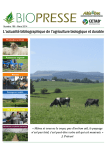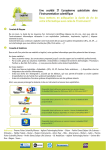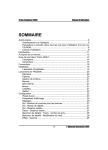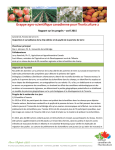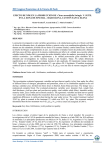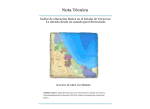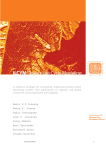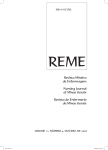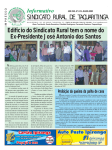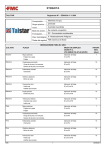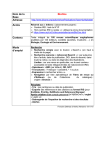Download Potential Distribution in Mexico of Diaphorina citri
Transcript
Potential Distribution in Mexico of Diaphorina citri (Hemiptera: Psyllidae) Vector of Huanglongbing Pathogen Author(s): I. Torres-Pacheco , J. I. López-Arroyo , J. A. Aguirre-Gómez , R. G. Guevara-González , R. Yänez-López , M. I. Hernández-Zul and J. A. QuijanoCarranza Source: Florida Entomologist, 96(1):36-47. 2013. Published By: Florida Entomological Society DOI: http://dx.doi.org/10.1653/024.096.0105 URL: http://www.bioone.org/doi/full/10.1653/024.096.0105 BioOne (www.bioone.org) is a nonprofit, online aggregation of core research in the biological, ecological, and environmental sciences. BioOne provides a sustainable online platform for over 170 journals and books published by nonprofit societies, associations, museums, institutions, and presses. Your use of this PDF, the BioOne Web site, and all posted and associated content indicates your acceptance of BioOne’s Terms of Use, available at www.bioone.org/page/ terms_of_use. Usage of BioOne content is strictly limited to personal, educational, and non-commercial use. Commercial inquiries or rights and permissions requests should be directed to the individual publisher as copyright holder. BioOne sees sustainable scholarly publishing as an inherently collaborative enterprise connecting authors, nonprofit publishers, academic institutions, research libraries, and research funders in the common goal of maximizing access to critical research. 36 Florida Entomologist 96(1) March 2013 POTENTIAL DISTRIBUTION IN MEXICO OF DIAPHORINA CITRI (HEMIPTERA: PSYLLIDAE) VECTOR OF HUANGLONGBING PATHOGEN I. TORRES-PACHECO1, J. I. LÓPEZ-ARROYO2, J. A. AGUIRRE-GÓMEZ3, R. G. GUEVARA-GONZÁLEZ1, R. YÁÑEZ-LÓPEZ1, M. I. HERNÁNDEZ-ZUL1 AND J. A. QUIJANO-CARRANZA1,* 1 Cuerpo Académico Ingeniería de Biosistemas, División de Investigación y Postgrado, Facultad de Ingeniería, Universidad Autónoma de Querétaro, México 2 Campo Experimental General Terán, Instituto Nacional de Investigaciones Forestales, Agrícolas y Pecuarias, México 3 Campo Experimental Bajío, Instituto Nacional de Investigaciones Forestales, Agrícolas y Pecuarias, México *Corresponding author; E-mail: [email protected] A pdf file with supplementary material for this article in Florida Entomologist 96(1) (2013) is online at http://purl.fcla.edu/fcla/entomologist/browse ABSTRACT Huanglongbing (HLB), the citrus disease associated with the bacteria ‘Candidatus Liberibacter asiaticus’, is the most important threat of the Mexican citrus industry. Since 2009, this bacterium has been detected in 11 out of 23 citrus producing states of the country, although with a limited distribution in each state. The Asian citrus psyllid (Diaphorina citri Kuwayama [Hemiptera: Psyllidae]) is the vector of this bacterium; the insect is distributed in all the citrus growing zones of Mexico. Presently, the lime production zone in the Mexican states of Colima, Jalisco, Michoacán, Nayarit, and Sinaloa, near to the Pacific Ocean coast, is the most affected by this disease. One of the main strategies to retard or stop the advance of HLB consists in the regional management of the psyllid populations. In order to contribute to the support of this strategy we analyzed the daily courses of temperature and rainfall all over the country to classify the citrus zones according to the probability of occurrence of favorable conditions for rapid and continuous psyllid reproduction. The results indicate that one of the most important regions of sweet orange production of Mexico, southern Veracruz and the region named “La Huasteca”, where the states of Veracruz, Tamaulipas, San Luis Potosi and Hidalgo converge, represent the zones with the highest risk for an accelerated reproduction of the psyllid. At present these regions remain free of the bacterium and are considered of highest priority for the management of psyllid populations and for preventing the entry and establishment of HLB. Key Words: risk analysis, degree days, deductive mapping, agro-ecological indexes RESUMEN El Huanglongbing (HLB), la enfermedad causada por la bacteria ‘Candidatus Liberibacter asiaticus’, es la amenaza más importante para la prevalencia de la industria citrícola mexicana. Desde 2009, el patógeno ha sido detectado en 11 de los 23 estados productores de cítricos del país, aunque con una distribución limitada en cada estado. El psílido asiático de los cítricos (Diaphorina citri Kuwayama) (Hemiptera: Psyllidae) es el vector de la bacteria y actualmente se encuentra distribuido en todas las zonas productoras de cítricos del país. Hasta ahora la mayor afectación por esta enfermedad corresponde a la zona comercial de producción de limón mexicano en los estados de Colima, Jalisco, Michoacán, Nayarit y Sinaloa en la costa del Océano Pacífico. Una de las estrategias que se han implementado para la contención de esta enfermedad es el manejo regional de poblaciones del psílido. Para contribuir a sustentar esta estrategia, analizamos las series históricas diarias de temperatura y precipitación de todo el país y clasificamos las zonas citrícolas con base en la probabilidad de presentar condiciones favorables para la reproducción continua y acelerada del psílido. Los resultados indican que de las regiones más importantes de producción de naranja dulce en el país, la parte sur de Veracruz y la región denominada “La Huasteca”, donde convergen los estados de Veracruz, Tamaulipas, San Luis Potosi e Hidalgo, presentan el riesgo más alto para la reproducción acelerada del psílido. Actualmente, esta región se encuentra libre de este patógeno y se considera de la más alta prioridad para el manejo de las poblaciones del psílido a fin de evitar el ingreso y establecimiento del HLB. Palabras Clave: análisis de riesgo, días grado, mapeo deductivo, índices agroecológicos Quijano et al. Potential distribution of Diaphorina citri in Mexico Since the beginning of this century, the American Continent has been under the invasion by the phloem limited bacterium ‘Candidatus Liberibacter asiaticus’, (Clas), which is associated with one of the most destructive citrus diseases, Huanglongbing (HLB or citrus greening) (da Graca 1991; da Graca & Korsten 2004; Bové & Garnier 2002; Bové 2006). Clas, which still cannot be cultured in vitro, can be transmitted by grafts and by the psyllid vectors, Trioza erytreae (Del Guerico) in Africa, and Diaphorina citri (Kuwayama) in Asia and now in American countries (Batool et al. 2007; da Graca 2008). In the Americas, HLB was reported for the first time in Brazil in 2004 (da Graca 1991). In Mexico, this disease was first reported in 2009, and its distribution in the country is still limited. The Mexican Government, through the General Direction for Plant Health (SAGARPA-SENASICA-DGSV) is on constant alert in an attempt to maintain the most important production zones of citrus (Sapindales: Rutaceae) free of HLB (Trujillo-Arriaga et al. 2008). The threat that this disease represents is greatly exacerbated by the wide distribution in Mexico of its effective vector, the Asian citrus psyllid, Diaphorina citri Kuwayama (López-Arroyo et al. 2009; Trujillo-Arriaga 2010). Because of the presence of HLB in Brazil and in the USA, Mexico in 2008 began a monitoring program of the bacterium that included sampling insects and citrus vegetative material. In 2009 Clas was detected first in the municipalities of Tizimin, state of Yucatán and Lazaro Cardenas, state of Quintana Roo, and then in plant and psyillid samples in the states of Jalisco and Nayarit. In 2010, HLB was found in Campeche, Colima, and Sinaloa (Trujillo-Arriaga 2010). At the end of 2011 the bacteria had been detected in the states of Baja California Sur, Michoacán, Chiapas, and Hidalgo for a total of 11 afflicted states (SENASICA 2012). Mexican lime (Citrus aurantifolia Swingle) is the citrus species predominantly affected by HLB in Mexico (Robles-González et al. 2011). This is the second most widely planted citrus species in the country with 166,580 ha planted, but sweet orange, Citrus × sinensis (L.) Osbeck, is the most important with 335, 471 ha planted. Presently, more than 10,000 ha of commercial groves have been reported as infected with Clas (SENASICA 2012). Histological studies developed by Esquivel-Chávez et al. (2012) showed that Mexican lime was the more susceptible to Clas and developed symptoms more rapidly than sweet orange and Persian lime, Citrus × latifolia Tanaka. The commercial groves of Mexican lime are distributed mainly in the states of Colima and Michoacán at the southern coast of the Pacific Ocean. The most important commercial groves of sweet orange are established in a region near the northern coast of the Gulf of Mexico with 258,546 h (77% of total) 37 distributed in the states of Veracruz, Tamaulipas, San Luis Potosí and Nuevo León according to data from the Agricultural and Fishery Information System of Mexico (www.siap.gob.mx 2012). The last inspections in these states have not detected the presence of the bacterium (SENASICA 2012). Some studies have estimated the risk associated with D. citri and with the HLB dispersal for different regions of Mexico (Díaz et al. 2010; Aldama-Aguilera et al. 2011). These studies classify almost all the important citrus zones of the country as being at high risk of Clas infection. This is so because these authors assign a similar weight to the area planted with citrus and to agrometeorological requirements of the establishment of D. citri. Our goal was to test the hypothesis that differences in agroclimatic conditions of citrus growing zones, determine the rates of psyllid population growth. The importance of pest-host-climate interactions in the progress of infections with Clas in citrus trees have been noted by several authors. Zhao (2010) and Bassanezi (2008) related the increasing in infection rates with the presence of high populations of the psyllid. On the other hand, the population dynamics of D. citri are strongly dependent on citrus phenology, because vegetative flushes must be available for the oviposition of the psyllid (Tsai et al. 2002; Hall & Albrigo 2007; Hall et al. 2007, 2011; Sétamou et al. 2008). Modeling techniques have been used to estimate the potential distribution of pests at the first stages of invasions, and model outputs are needed to support the planning of surveys and implementation of eradication measures (Rafos 2003; Magarey et al. 2007; Arambout et al. 2009; Ladányi & Horváth 2010; Rosa et al. 2011; Gutierrez & Ponti 2011). Computer systems based on models of pest behavior have been developed to estimate potential pest distribution and to create pest risk maps as in the case of NAPPFAST (North Carolina State University APHIS Plant Pest Forecasting System), an internet based system to develop risk maps of plant pests (Magarey et al. 2007). The system has a daily based climate database and a biological template to create simple models. Similarly CLIMEX (Climatic Index) is a computer system that estimates the climatic regions that a species could potentially occupy when there are no limiting factors other than climate (Sutherst et al. 1999; Sutherst 2004; Beddow et al. 2010). In addition, BIOCLIM (Bioclimatic Analysis And Prediction System), created by Busby (1991), and MAXENT (Maximum Entropy Method), developed by Phillips et al. (2006) have been used to estimate spread patterns of plant pests (Dupin et al. 2011; Kriticos et al. 2012). Quijano et al. (2011) developed a computer system named SIMPEC (Information System to Assess Ecological Potential Production of Crops), which 38 Florida Entomologist 96(1) integrates a daily weather database, a national database of soil profiles, and models to simulate the growth and development of crops and pests. For insects, SIMPEC includes a simple algorithm to calculate the number of generations based on the degree days approach, and a routine to estimate the probability of favorable conditions for an organism. This study proposes a deductive mapping approach based on the analysis of the climatic conditions to delimit the most suitable zones for the development and growth of Asian citrus psyllid populations. These zones are considered to be at the highest risk of developing new infections of Clas, the apparent cause of HLB in citrus trees. MATERIALS AND METHODS The data generated in this study are displayed in black and white in Figs. 1-6. These figures are reproduced in color in the online supplementary document at http://purl.fcla.edu/fcla/entomologist/browse. The figures in the supplementary document are referred to below as Suppl. Fig. 1, Suppl. Fig. 2, etc. March 2013 Factors Affecting Distribution of Diaphorina citri. The potential distribution of D. citri was considered to be determined by 2 main factors: a) the availability of susceptible hosts, and b) the suitability of climatic conditions for the development of D. citri. The availability of susceptible hosts was delimited by considering the total area of planted citrus in Mexico, including sweet orange, Mexican lime, tangerine (Citrus reticulata Blanco), and pummelo (Citrus maxima Burm. Merr.). Data of areas planted were obtained from the Agricultural and Fishery Information System of Mexico (Servicio de información Agropecuaria y Pesquera, SIAP). Citrus zones were classified according to the probability of occurrence of favorable temperatures for vegetative bud growth of citrus, i.e., shoots or flushes. The range of temperatures of 13-35 °C was considered (Hardy & Khurshid 2007) to be generally operative for growth and development of citrus species. Two indexes were calculated to estimate the period of the yr with suitable conditions for the production of vegetative shoots: (i) the index of favorable temperatures for citrus growing (IFTCG), and (ii) the index of the length of the growing Fig. 1. Distribution of HLB detections in Mexico in December, 2011. Quijano et al. Potential distribution of Diaphorina citri in Mexico 39 Fig. 2. Climatic suitability map for Citrus growth as a function of temperature in Mexico. period for citrus (ILGPC), which estimates the number of days with sufficient soil moisture for vegetative growth. The formulas for these indexes are shown below: IFTCG = No. of days with mean daily temperature ranging in the citrus threshold during the yr/No. of days of the yr ILGPC = No. of days with available humidity for citrus growing during the yr / No of days of the yr. The length of the growing period was calculated on a daily basis through a simple water balance in which rainfall (P) is compared with potential evapotranspiration (PET) following the method proposed by the Food and Agricultural Organization (FAO) (1996). When P exceeds half PET the growing period is considered to start and residual moisture storage is calculated as a function of soil physical properties. The growing period ends when residual moisture is completely exhausted. Under these considerations, days of the yr are counted as favorable for growing of citrus when some residual humidity is available (P-PET > 0), and non-favorable when there is not any residual humidity. Irrigation was not included in the water balance, considering that the in the case of sweet orange more than 70% of the cultivated area is under rainfed conditions. The suitability of climatic conditions for D. citri was analyzed with 3 different criteria, the index of favorable temperatures for D. citri development (IFTVD), the index of favorable temperatures for D. citri oviposition (IFTVO) and an index of potential generations of the insect in a yr (INPGV). The first 2 indices represent the fraction of the yr with favorable temperatures for the insect’s development, and oviposition respectively. The third index represents the proportion of the maximum number of generations estimated for D. citri in the country for every yr, and was considered as an indicator of the probability of high developmental rates for this insect. The calculation of these indexes was as follows: IFTVD = No. of days with mean daily temperature ranging in the vector threshold during the yr / No. of days of the yr 40 Florida Entomologist 96(1) IFTVO = No. of days with mean daily temperature ranging in the vector’s oviposition threshold during the yr / No. of days of the yr INPGV = number of potential generations of D. citri in a yr / Maximum number of Potential Generations obtained March 2013 The number of potential generations (NPG) of D. citri in a yr was calculated as follows: the D. citri potential distribution was treated as an independent information layer or shape. In the case of host availability data consisted on planted area with citrus species at the municipality level. This shape was overlaid with the land use layer to acquire the agricultural land where citrus is present. Data were interpolated using the inverse distance weighted procedure (Shepard 1968). Weather data were analyzed at a daily level and the different indexes were calculated for every yr of the time series for every weather station. The curve of probability of exceedance was calculated for every station and the values of the indexes corresponding to the 80% of probability were used to elaborate the maps. To analyze the plausibility of the proposed regionalization, the actual distribution of HLB was considered as a reference. Fig. 1 and Suppl. Fig. 1 show the sites with HLB detections in Mexico from Mar 2009 to Dec 2011. The Yucatan Peninsula and the Middle Western coast of the Pacific Ocean with a tropical climate are the most affected areas by HLB. In some other areas Claspositive psyllids have been found but not infected trees. NPG = Accumulated DD in a yr / DD required to complete one generation RESULTS AND DISCUSSION Temperatures of 10 °C and 33 °C were considered as the minimum and maximum thresholds for the development of this insect (Liu & Tsai 2000), meanwhile 16 °C and 41.6 °C were used to represent the minimum and maximum oviposition threshold temperatures, respectively (Hall et al. 2011). A thermal requirement of 250.3 Degree Days (DD) to complete the life cycle from egg to adult (Liu & Tsai 2000) was utilized to calculate the number of potential generations of D. citri. To estimate daily DD the residual method was applied which has the following formula: Daily DD = ((Tmax +Tmin)/2)-Lower threshold temperature Finally, an Integrated Index of Climatic Suitability (IICS) for D. citri was calculated combining the different indexes following a similar procedure as Moschini et al., (2010). A simple average was used for combining them: IICS = (IFTCG + ILGPC + IFTVD + IFTVO + INPGV) / 5 Climatic Database Daily data of the meteorological variables rainfall (rain, mm), maximum temperature (Tmax, °C), and minimum temperature (Tmin, ° C), were utilized from 2985 weather stations of the National Weather Service (SMN) of Mexico. Observed values of these variables represent series from 1950 through 2010. Data quality control was performed through an exhaustive visual inspection of yearly graphics for each variable. After the elimination of invalid or illogical values, data from 2,470 weather stations with a time series of at least 18 yr in the period of 1967 to 2008 were considered. The average time series of the finally selected weather stations was 23 yr. The weather database was saved as a text format files and incorporated to the SIMPEC structure to perform the analysis. Mapping Procedure Maps were created using the software Arc Map ver. 10.1. Every factor considered to affect The results of the 56,810 simulations for the 4 criteria analyzed and the integrated index are shown in Table 1. The comparison of the mean of days with favorable temperatures for citrus (98.55) and for the psyllid (211.7) indicates that this factor is more restrictive for the tree than for the insect. In northern locations, temperatures remain below the citrus requirements in the winter. This also indirectly affects the growth and development of the psyllid, because of the lack of vegetative shoots in the winter. The mean of days with favorable soil moisture for citrus was 200.75. The maximum number of potential psyllid generations obtained was 27, with a mean value of 14. The values of the standard deviations for these factors are indicative of the great variability of the climatic conditions in the Mexican citrus zones. Index of Susceptible Host Availability Figure 2 and Fig. 3 (and Suppl. Figs. 2 and 3) show the maps of 80% of probability of exceedance for the 2 indexes describing the susceptible host availability: the days of the yr within the thermal thresholds for the citrus growing (IFTCG) (Fig. 2), and the period with available soil moisture for rainfed cultivation of citrus (ILGPC) (Fig. 3). In both maps, the dark red color in the scale represents the most suitable conditions for citrus growing. In the case of temperature (Fig. 2 and Suppl. Fig. 2), a gradual decrease in the values of the index is evident from south towards northern lati- 0 0.84 0.51 0.18 0 0.85 0.5 0.19 0 27 14 5.2 0 0.99 0.34 0.28 0 0.92 0.58 0.19 0 361.02 124.11 102.01 3 2 index of favorable temperatures for citrus growing. index of length of the growing period for citrus. index of favorable temperatures for D. citri development. 4 index of favorable temperatures for D. citri oviposition. 5 index of potential generations of D. citri in a year. 6 Integrated Index of Climatic Suitability for D. citri. Index of Climatic Suitability for D. citri Development 1 0 1 0.27 0.4 0 335.8 200.75 87.6 0 0.92 0.45 0.24 0 365 98.55 146 Min Max Mean Std dev 41 tudes. In the states of Campeche, Chiapas, Quintana Roo, southern Veracruz, Tabasco, Yucatan, and the coastal zones of Colima, Guerrero, and Michoacan, the maximum suitability of temperatures for citrus growing is present as indicated by the red color. This implies that during the whole yr the temperature is favorable for the production of vegetative shoots, and therefore for the development and continuous increase of the D. citri population (Liu & Tsai 2000; Tsai et al. 2002; Hall et al. 2007, 2011). With respect to the growing period, there is a remarkable contrast between the southern and northern regions. In the south of the country, humidity is available for growth throughout the yr. In comparison, the states of northern Mexico like Baja California, Nuevo León, Sinaloa, Sonora, and Tamaulipas, the period with at least minimally sufficient soil moisture covers 10% or less of the yr. Such contrasts could have determined the pattern in the Mexican citrus industry distribution, with the presence of irrigated citrus groves mainly in the northern states of the country, and with the concentration of Mexican and Persian lime production in southern Mexico (www.siap.gob.mx). These contrasts also help to understand the differences in the seasonality of citrus shoot production. In southern Mexico, vegetative growth occurs throughout the yr, which is especially evident in the different lime species; whereas in the northern states, productive citrus trees mainly have shoot production during the fall and at the end of the winter (Curti-Díaz et al. 1996, 1998; Medina-Urrutia et al. 2008; SENASICA 2008; Rocha & Padrón 2009). As can be seen in Fig. 1 and Suppl. Fig 1, the zones where HLB is currently present in Mexico are coincident with the more suitable areas for citrus production. 0 335.8 211.7 69.35 Integrated IICS6 INPGV5 No. of Gen. IFTVD3 IFTVO4 Ovipos. Develop. ILGPC2 Days with favorable soil moisture IFTCG1 Days with favorable temperature Parameter Days with favorable temperature Citrus tree Diaphorina citri TABLE 1. BASIC STATISTICS OF THE RESULTS OF 56,810 SIMULATIONS PERFORMED FOR THE 4 AGRO-CLIMATIC CRITERIA ANALYZED IN RELATION TO DISTRIBUTION OF THE ASIAN CITRUS PSYLLID AND CITRUS PHENOLOGY. Quijano et al. Potential distribution of Diaphorina citri in Mexico Figures 4, 5 and 6 (and Suppl. Figs. 4, 5 and 6) show the maps of temperature conditions for the growth and development of D. citri at a probability of exceedance of 80%. The Index of days within the thermal thresholds for the insect development (IFTVD) and oviposition are described in Fig. 4, and Fig. 5, and the number of generations that the psyllid can complete in a yr as a proportion of the maximum obtained (INPGV) are presented in Fig. 5. For the first index (IFTVD), zones with medium to high risk for the occurrence of suitable temperatures for D. citri development are distributed throughout the country with the only exception of the states of Baja California and Sonora (Fig. 4). In the states of Campeche, Chiapas, Quintana Roo, Tabasco, Yucatán, some parts of Guerrero, and the region named “La Huasteca” where the states of Hidalgo, San Luis Potosí, Tamaulipas, and Veracruz converge, the temperature conditions are favorable for this 42 Florida Entomologist 96(1) March 2013 Fig. 3. Climatic suitability map for Citrus growth as a function of soil moisture conditions in Mexico. Fig. 4. Climatic suitability map for Diaphorina citri growth as a function of temperature in Mexico. Quijano et al. Potential distribution of Diaphorina citri in Mexico 43 Fig. 5. Climatic suitability map for Diaphorina citri oviposition as a function of temperature in Mexico. Fig. 6. Climatic suitability map showing the different numbers of generations of Diaphorina citri in various areas of Mexico. The number of generations are depicted as follows: purple, 0; blue, 3; blue-green, 5; dark green, 8; medium green, 10; light green, 13; yellow, 16; orange, 19; pink, 22; red, 25; and brown, 27. 44 Florida Entomologist 96(1) March 2013 Fig. 7. Climatic suitability map for Diaphorina citri and citrus as a function of the Integrated Indexes. insect almost throughout the yr (Fig. 4). In the case of oviposition (IFTVO), the temperature conditions are more restrictive for the vector, with all the northern states getting a medium to low risk classification. Southern states present favorable conditions of temperature for oviposition in a great proportion of the yr, especially Michoacan, Guerrero, Oaxaca, Veracruz, Tabasco, Campeche, Yucatan, Quintana Roo, and Chiapas (Fig. 5). With respect to the number of generations of D. citri, the areas with the highest risk to reach the maximum number are distributed within the states of Colima, Jalisco, Michoacán, Nayarit, Sinaloa, Tabasco, Veracruz, and Yucatán. This map is coincident with the reports of high populations of D. citri and HLB detections (Urías-López et al. 2011; Velázquez-Monreal et al. 2011; www. senasica.gob.mx). Considering the states where the disease has been undetected, the northern zone of Veracruz and southern Tamaulipas present the most favorable conditions for the insect, and where it can develop more than 11 generations per yr (Fig. 6). This indicates the constant threat of the arrival and development of Clas-carrying psyllids. The citrus zone of Nuevo Leon reaches a medium risk classification with 6 generations per yr (Fig. 6). The distribution of the Integrated Index of Agroclimatic risk for D. citri in the citrus zones of Mexico (IICS) is shown in Fig. 7. This index represents the average of the different criteria used in this approach, summarizing the factors of susceptible host availability and favorable climate for the vector. In the resulting map, the highest risk (0.8 to 0.9) occurs in some regions of Chiapas, Quintana Roo, Tabasco, Veracruz, and Yucatan. It implies that most of the yr in those zones, there can be citrus trees with vegetative growth and favorable temperatures for the reproduction of the insect. Studies about the abundance of D. citri in Michoacán, Veracruz, and Yucatan (JassoArgumedo et al. 2010, Miranda-Salcedo & LópezArroyo 2011, Ortega-Arenas et al. 2011) confirm the results generated in this work. In the region of “La Huasteca” (Tamaulipas, San Luis Potosi, Hidalgo and Veracruz), Guerrero, Michoacán, Colima, and scattered zones of Jalisco and Nayarit, the risk of climatic suitability ranks from 0.7 to 0.8. Some zones of Jalisco, Nayarit, Central Tamaulipas and the state of Sinaloa register medium Quijano et al. Potential distribution of Diaphorina citri in Mexico values of this index (0.6 to 0.7). In Nuevo León, Sonora, great part of Jalisco, northern Tamaulipas, and Baja California, the risk of favorable conditions for the development of D. citri can be considered medium to low ()0.5) (Fig. 7). Implications for the Management of D. citri and HLB In general, pest risk maps provide a scientific basis to decide where to allocate resources for pest monitoring and surveying. Through this approach, the design and operation of regional management strategies can be more efficient in tracking invasive pests using the available agroclimatic information and saving human efforts and economic resources. Current citrus zones with presence of HLB in Mexico meet the criteria of climatic suitability for a continuous production of vegetative shoots and high reproduction rates of D. citri. These areas have a humid tropical megathermal climate according to the Köppen classification, as well as the zones reported with HLB infections in Brazil, Cuba and the state of Florida in USA. Southern Veracruz and “La Huasteca” are the zones with the highest risk for D. citri increasing populations due to its similarity in climate conditions with the currently HLB infected zones in Mexico (see Figs. 1 and 7). These zones are the most important of the country in terms of sweet orange production and should be considered as the highest priority in crop protection actions in order to suppress the psyllid populations and to prevent their spread throughout the commercial groves. The state of Tamaulipas, in its central part, presents a medium to high risk and should also be considered to be in serious danger. Only Nuevo Leon, Sonora and Baja California have climatic conditions that could greatly facilitate the management of the vector; mainly because scarce populations of D. citri are predictable since there are only 2 vegetative flushes during the yr. Our study could contribute substantially to planning the regional approach intended for the management of D. citri in Mexico. ACKNOWLEDGMENTS The authors acknowledge The Consejo Nacional de Ciencia y Tecnologia of Mexico for fellowship support of Juan Ángel Quijano-Carranza, and for providing the financing for the project “Manejo de la enfermedad Huanglongbing (HLB) mediante el control de poblaciones del vector Diaphorina citri (Hemiptera: Psyllidae), el psílido asiático de los cítricos (108591)” from which this work was derived. REFERENCES CITED ALDAMA-AGUILERA, C., OLVERA-VARGAS, L. A., AND GALINDO-MENDOZA, M. A. 2011. Reportes epidemiológicos de HLB, pp. 122-127 En Memoria del 2° Simposio 45 Nacional sobre investigación para el manejo del Psílido Asiático de los Cítricos y el Huanglongbing en México. Texcoco, México. https://sites.google.com/ site/diaphorina/hlb2simpnal. ARAMBOUT, J. P., FINLAY, K. J., LUCK, J., AND BEATTIE, G. A. C. 2009. A concept model to estimate the potential distribution of the Asiatic citrus psyllid (Diaphorina citri Kuwayama) in Australia under climate change − A means for assessing biosecurity risk. Ecological Modelling 220: 2512-2524. BASSANEZI, R. B. 2008. Epidemiology of huanglongbing and its implications on disease management, pp. 37-43 In Memoria del 2°. Taller Internacional sobre Huanglongbing de los cítricos (Candidatus Liberibacter spp) y el psílido asiático de los cítricos (Diaphorina citri). Hermosillo, Sonora, Mexico. http://www. calcitrusquality.org/wp-content/uploads/2009/05/Epidemiology-of-HLB-and-its-implications-on-diseasemanagement-Bassanezi-2010.pdf. BATOOL, A., IFTIKHAR, Y., MUGHAL, S. M., KHAN, M. M., JASKANI, M. J., ABBAS, M., AND HAN, I. A. 2007. Citrus greening disease-a major cause of citrus decline in the world: A review. Hort. Sci. (Prague) 34: 159-166. BEDDOW, J. M., KRITICOS, D., PARDEY, P. G., AND SUTHERST, R. W. 2010. Potential Global Crop Pest Distributions Using CLIMEX: HarvestChoice Applications. Working Paper. 27 pp. http://harvestchoice.org/sites/ default/files/downloads/publications/Beddowetal2010HCPotentialGlobalCropPestDistributionsUsingCLIMEX~3.pdf BOVÉ, J. M. 2006. Huanglongbing: A destructive, newly-emerging, century-old disease of citrus. J. Plant Pathol. 88(1): 7-37. BOVÉ, J. M., AND GARNIER, M. 2002. Phloem- and xylemrestricted plant pathogenic bacteria. Plant Science 163: 1083-1098. BUSBY, J. R. 1991. BIOCLIM - A bioclimatic analysis and prediction system, pp. 64-68 In C. R. Margules and M. P. Austin [eds.], Nature Conservation: Cost Effective Biological Surveys and Data Analysis. CSIRO, Canberra. CURTI-DÍAZ, S. A., DÍAZ-ZORRILLA, U., LOREDO-SALAZAR, R. X., SANDOVAL, J. A., PASTRANA, L., AND RODRÍGUEZ, M. 1998. Manual de producción de naranja para Veracruz y Tabasco. Libro Técnico No. 2. INIFAP, Centro de Investigación Regional Golfo Centro, Campos Experimentales Ixtacuaco y Huimanguillo, Veracruz y Tabasco, México. 175 pp. CURTI-DÍAZ, S. A., LOREDO-SALAZAR, R. X., DÍAZ-ZORRILLA, U., SANDOVAL, J. A., AND HERNÁNDEZ, J. 1996. Manual de producción de limón Persa. Folleto Técnico 14. INIFAP, Centro de Investigación Regional Golfo Centro, Campo Experimental Ixtacuaco. Tlapacoyán, Ver., México. 145 pp. DA GRACA, J. V. 1991. Citrus greening disease. Annu. Rev. Phytopathol. 29: 109-136. DA GRACA, J. V., AND KORSTEN, L. 2004. Citrus huanglongbing: Review, present status and future strategies, pp. 229-245 In S. A. M. H. Naqvi [ed.], Diseases of fruits and vegetables, Vol. 1. Kluwer Academic Publishers. The Netherlands. DA GRACA, J. V. 2008. Biology, history and world status of huanglongbing. I Taller Intl. sobre Huanglongbing de los cítricos (‘Candidatus Liberibacter spp.’) y el psílido asiático de los cítricos (Diaphorina citri). Hermosillo, Sonora, México. http://www.concitver. com/huanglongbingYPsilidoAsiatico/MemorC3ADa1Graca.pdf 46 Florida Entomologist 96(1) DÍAZ P., G., MORA A., G., LÓPEZ A., J. I., GUAJARDO P., R., AND SÁNCHEZ C. I. 2010. Modelación espacial de zonas de riesgo agroclimático para el desarrollo de Diaphorina citri en zonas citrícolas del estado de Veracruz. Caso de estudio naranja En Memorias del XIV Simp. Intl. SELPER. DUPIN, M., BRUNEL, S., BAKER, R., EYRE, D., AND MAKOWSKI, D. 2011. A comparison of methods for combining maps in pest risk assessment: application to Diabrotica virgifera virgifera. EPPO Bull. 41: 217-225. ESQUIVEL-CHÁVEZ, F., VALDOVINOS-PONCE, G., MORA-AGUILERA, G., GÓMEZ-JAIMES, R., VELÁZQUEZ-MONREAL, J., MANZANILLA-RAMÍREZ, M. A., FLORES-SÁNCHEZ, J. L., AND LÓPEZ-ARROYO, J. I. 2012. Análisis histológico en cítricos agrios y naranja dulce asociados a síntomas ocasionados por Candidatus Liberibacter asiaticus. Agrociencia. (Submitted). FOOD AND AGRICULTURAL ORGANIZATION. 1996. Agro-ecological zoning guidelines. FAO Soils Bull. 73. Soil Resources, Management and Conservation Service. FAO Land and Water Development Division. GUTIERREZ, A. P., AND PONTI, L. 2011. Assessing the invasive potential of the Mediterranean fruit fly in California and Italy. Biol. Invasions 13: 1387-1402. HALL, D. G., AND ALBRIGO, L. G. 2007. Estimating the relative abundance of flush shoots in citrus, with implications on monitoring insects associated with flush. HortScience 42: 364-368. HALL, D. G., LAPOINTE, S. L., AND WENNINGER, E. K. 2007. Effects of particle film on biology and behavior of Diaphorina citri (Hemiptera: Psyllidae) and its infestations in citrus. J. Econ. Entomol. 100: 847-854. HALL, D. G., WENNINGER, E. J., AND HENTZ, M. G. 2011. Temperature studies with the Asian citrus psyllid, Diaphorina citri: Cold hardiness and temperature thresholds for oviposition. J. Insect Sci. 83:1-15. HARDY, S., AND KHURSHID, T. 2007. Calculating heat units for citrus. Primefacts, NSW department of primary industries, Primefact 749. 3 pp. JASSO-ARGUMEDO, J., LOZANO-CONTRERAS, M., BARROSOAKÉ, H., AND LÓPEZ-ARROYO, J. I. 2010. Abundancia estacional de Diaphorina citri (Hemiptera: Psyllidae) y sus enemigos naturales en huertas de limón persa en Yucatán, México, pp. 311-318 In J. I. LópezArroyo y V. W. González-Lauck [Comp.], Memorias del Primer Simposio Nacional sobre Investigación para el Manejo del Psílido Asiático de los Cítricos y el Huanglongbing y en México. 8-9 Diciembre 2010. Monterrey, N.L., México. https://sites.google.com/ site/diaphorina/simposiohlb1_050 001. KRITICOS, D. J., WEBBER, B. L., LERICHE, A., OTA, N., MACADAM, I., BATHOLS, J., AND SCOTT, J. K. 2012. CliMond: global high-resolution historical and future scenario climate surfaces for bioclimatic modelling. Methods in Ecology and Evolution 3: 53-64. LADÁNYI, M., AND HORVÁTH, L. 2010. A review of the potential climate change impact on insect populations – General and agricultural aspects. Appl. Ecol. Environ. Res. 8: 143-152. LIU, Y. H., AND TSAI, J. H. 2000. Effects of temperature on biology and life table parameters of the Asian citrus psyllid, Diaphorina citri Kuwayama (Homoptera: Psyllidae). Ann. Appl. Biol. 137: 201-206. LÓPEZ-ARROYO, J. I., JASSO, J., REYES, M. A., LOERA-GALLARDO, J., CORTEZ-MONDACA, E., AND MIRANDA, M. A. 2009. Perspectives for biological control of Diaphorina citri (Hemiptera: Psyllidae) in Mexico, pp. 329330 In T. R. Gottwald and J. H. Graham [eds.], Proc. March 2013 Intl. Res. Conf. Huanglongbing. 1-5 Dec 2008. Orlando, Florida. MAGAREY, R. D., FOWLER, G. A., BORCHERT, D. M., SUTTON, T. B., COLUNGA-GARCÍA, M., AND SIMPSON, J. A. 2007. NAPPFAST: An internet system for the weatherbased mapping of plant pathogens. Plant Disease 91: 336-345. MEDINA-URRUTIA, V. M., ROBLES-GONZÁLEZ, M. M., BECERRA-RODRÍGUEZ, S, OROZCO-ROMERO, J., OROZCO SANTOS, M., GARZA-LÓPEZ, J. G., OVANDO-CRUZ, M. E., AND CHÁVEZ-CONTRERAS, X. 2008. El cultivo de limón Mexicano. Libro Técnico Núm. 1. Campo Experimental Tecomán. INIFAP-SAGARPA. México. 188 pp. MIRANDA-SALCEDO, M. A., AND LÓPEZ-ARROYO, J. I. 2010. Fluctuación poblacional del psílido asiático de los cítricos Diaphorina citri Kuwayama (Hemiptera: Psyllidae) y de sus enemigos naturales en Michoacán En Memoria del 1er. Simp. Nac. sobre investigación para el manejo del Psílido Asiático de los Críticos y el Huanglongbing en México. https://sites.google.com/ site/diaphorina/hlb2simpnal. ORTEGA-ARENAS, L. D., VILLEGAS-MONTER, A., ORDUÑOCRUZ, N., VEGA-CHÁVEZ, J., LOMELÍ-FLORES, J. R., AND RODRÍGUEZ-LEYVA, E. 2010. Fluctuación poblacional de Diaphortina citri y enemigos naturales asociados a especies de cítricos en Cazones, Veracruz, México, pp. 56 -63 Memoria del 1er Simposio Nacional sobre investigación para el manejo del Psílido Asiático de los Críticos y el Huanglongbing en México. MOSCHINI, R. C., HEIT, G. E., CONTI, H. A., CAZENAVE, G., AND CORTESE, P. L. 2010. Riesgo agroclimático de las áreas citrícolas de Argentina en relación a la abundancia de Diaphorina citri. Informe de enero 2010. Programa Nac. de prevención del Huanglongbing. Ministerio de Agricultura Ganadería y Pesca. Presidencia de la nación. Buenos Aires, Argentina. 14 pp. ORTEGA-ARENAS, L. D., VILLEGAS-MONTER, A., ORDUÑOCRUZ, N., VEGA-CHÁVEZ, J., LOMELÍ-FLORES, J. R., AND RODRÍGUEZ-LEYVA, E. 2011. Abundancia estacional de Diaphortina citri y enemigos naturales asociados a especies de cítricos en Cazones, Veracruz, México. Memoria del 2o. Simposio Nac. sobre investigación para el manejo del Psílido Asiático de los Críticos y el Huanglongbing en México. https://sites.google.com/ site/diaphorina/hlb2simpnal QUIJANO-CARRANZA J. A., ROCHA-RODRÍGUEZ, R., AND AGUIRRE-GÓMEZ, J. A. 2011. Sistema de Información para el Monitoreo del Potencial Ecológico de los Cultivos, SIMPEC. INIFAP-SAGARPA México. Publ. técnica no. 2. 32 pp. RAFOS, T. 2003. Spatial stochastic simulation offers potential as a quantitative method for pest risk analysis. Risk Analysis 23: 651-661. ROBLES-GONZÁLEZ, M. M., VELÁZQUEZ-MONREAL, J. J., MANZANILLA-RAMÍREZ, M. Á., OROZCO-SANTOS, M., FLORES-VIRGEN, R., AND MEDINA-URRUTIA, V. M. 2011. El HLB en árboles de limón mexicano [Citrus aurantifolia (Christm.) Swingle] su dispersión y síntomas en Colima, México, pp. 43-53 In J. I. López Arroyo and V. W. González Lauck [Comp.], 2° Simposio Nacional sobre Investigación para el Manejo del Psílido Asiático de los Cítricos y el Huanglongbing en México, Montecillo, Edo. de México, México.l 5 y 6 de diciembre 2011. ISBN 978-607-425-680-2. 424 pp. ROCHA, M. A., AND PADRÓN, J. E. [eds.]. 2009. El cultivo de los cítricos en el Estado de Nuevo León. Libro científico no. 1. Inst. Nacl. Invest. Forestales, Agríco- Quijano et al. Potential distribution of Diaphorina citri in Mexico las y Pecuarias. CIRNE. Campo Experimental Gral. Terán. México. 474 pp. ROSA, G. S. COSTA, M. I. S., CORRENTE, J. E., SILVEIRA, L. V. A., AND GODOY, W. A. C. 2011. Population dynamics, life stage and ecological modeling in Chrysomya albiceps (Wiedemann) (Diptera: Calliphoridae). Neotrop. Entomol. 40: 181-189. SENASICA (SERVICIO NACIONAL DE SANIDAD INOCUIDAD Y CALIDAD AGROALIMENTARIA). 2008. Manual técnico para la detección del Huanglongbing de los cítricos. Dirección General de Sanidad Vegetal. Dirección de Protección Fitosanitaria. SENASICA (SERVICIO NACIONAL DE SANIDAD INOCUIDAD Y CALIDAD AGROALIMENTARIA). 2012. Acciones contra el Huanglongbing y su vector en México. Informe del 02 de enero al 30 de junio de 2012. Dirección General de Sanidad Vegetal. Dirección de Protección Fitosanitaria. SÉTAMOU, M., FLORES, D., FRENCH, J. V., AND HALL, D. G. 2008. Dispersion patterns and sampling plans for Diaphorina citri (Hemiptera: Psyllidae) in citrus. J. Econ. Entomol. 101(4): 1478-1487. SHEPARD, D. 1968. A two-dimensional interpolation function for irregularly-spaced data, Proc. 23rd Natl. Conf. Assoc. Computing Machinery. pp. 517-524. SUTHERST, R. W. 2004. Prediction of species’ geographical ranges. A critical comment on M. J. Samways, R. Osburn, H. Hastings and V. Hattingh. 1999. Global climate change and accuracy of prediction of species geographical ranges: establishment success of introduced ladybirds (Coccinellidae, Chilocorus spp. ) worldwide. J. Biogeography 26, 795-812. J. Biogeogr. 30: 805-816. TRUJILLO-ARRIAGA, J., SÁNCHEZ-ANGUIANO, H. M., AND ROBLES-GARCIA, P. L. 2008. En Memoria del 1er. Taller Intl. sobre Huanglongbing de los cítricos (Candidatus Liberibacter spp.) y el psílido asiático de los cítricos (Diaphorina citri). Hermosillo, Sonora, México. 47 http://www.concitver.com/huanglongbingYPsilidoAsiatico/Indice.html TRUJILLO-ARRIAGA, J. 2010. Situación actual, regulación y manejo del HLB en México En Memoria del 2°. Taller Intl. sobre el Huanglongbing y el Psílido Asiático de los Cítricos. Mérida, Yucatán Mexico. https:// sites.google.com/site/diaphorina/tallerhlb TSAI, H. T., WANG, J. J., AND LIU, Y. H. 2002. Seasonal abundance of the Asian citrus psyllid Diaphorina citri (Homoptera: Psyllidae) in southern Florida. Florida Entomol. 85: 446-451. URÍAS-LÓPEZ, M. A., HERNÁNDEZ-FUENTES, L. M., LÓPEZARROYO, J. I., AND GARCÍA-ÁLVAREZ, N. C. 2011. Distribución temporal y densidades de poblacion del psílido asiático de los cítricos (Hemiptera: Psyllidae) en Nayarit, México, pp. 156-162 In J. I. López Arroyo and V. W. González Lauck [Comp.], 2° Simp. Nac. sobre Investigación para el Manejo del Psílido Asiático de los Cítricos y el Huanglongbing en México, Montecillo, Edo. de México, México. 5 y 6 de diciembre 2011. ISBN 978-607-425-680-2. 424 pp. VELÁZQUEZ-MONREAL, J. J., ROBLES-GONZÁLEZ, M. M., MANZANILLA-RAMÍREZ, M. Á., CARRILLO-MEDRANO, S. H., AND OROZCO-SANTOS, M. 2011. Dinámica poblacional de Diaphorina citri Kuwayama (Hemíptera: Psyllidae), en el estado de Colima, pp. 161-168 In J. I. López Arroyo and V. W. González Lauck [Comp.], 2° Simp. Nac. sobre Investigación para el Manejo del Psílido Asiático de los Cítricos y el Huanglongbing en México, Montecillo, Edo. de México, México. 5 y 6 de diciembre 2011. ISBN 978-607-425-680-2. 424 pp. ZHAO, X. 2010. Background, current situation and management of the HLB and its vector in China, pp. 4452 In Memoria del 2°. Taller Intl. sobre Huanglongbing de los cítricos (Candidatus Liberibacter spp) y el psílido asiático de los cítricos (Diaphorina citri). Hermosillo, Sonora, Mexico.















